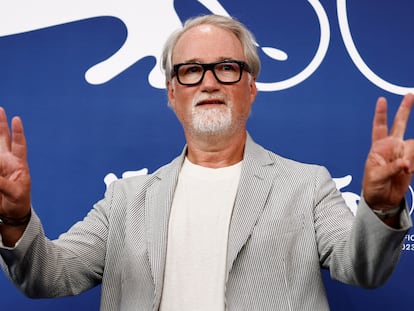The ‘Fight Club’ phenomenon: How 30 pages written in a truck repair shop became an object of worship among radical groups
A cultural product cannot be controlled once it is out there, says director David Fincher, who is now releasing ‘The Killer’ on Netflix. This is the case of his most famous work, a film that has been claimed by the extreme right
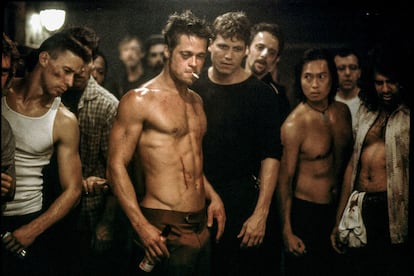
In May 2009, a 17-year-old high school student exploded a fire bomb in a New York Starbucks, causing serious damage. Eight years later, in August 2017, another young white American attempted to carry out a bomb attack, this time against an Oklahoma City bank. In subsequent interrogations, both turned out to have something in common: their love for Fight Club (1999) and their willingness to put into practice the violent plan of anti-capitalist agitation known as Project Mayhem that is a fundamental part of the film’s plot. Two examples of the sinister impact that this dark, fertile work has had on all kinds of extremists and enlightened people since it hit theaters at the end of the last millennium.
Released in November 1999 after a lukewarm premiere at the Venice Festival, Fight Club received unusually ferocious criticism. Alexander Walker of the Evening Standard called it neo-Nazi trash, deeming it a frontal assault against sanity and decency that took violence and moral pettiness to pornographic extremes. David Denby, in The New Yorker, described it as “a fascist rhapsody.” Lisa Schwarzbaum, in Entertainment Weekly, called the film’s premise “idiotic.” Roger Ebert of the Chicago Sun-Times opined that it was cinematographically impeccable, but very dubious philosophically, and Christopher Godwin, of The Australian, predicted that the film, despite its virtues, would give rise to outbreaks of nihilistic, antisocial violence, as had happened 30 years earlier with A Clockwork Orange.
It was 20th Century Fox’s big bet for the final stretch of the year. The fourth feature film by its director, David Fincher, after the successes of Alien 3, Seven and The Game, cost $65 million and was expected to gross at least three times that amount. In its first weekend, benefiting from an aggressive marketing campaign that associated it with the world of wrestling and mixed martial arts, the film grossed a promising $11 million, surpassing productions such as Bruce Beresford’s Double Jeopardy and Rob Reiner’s The Story of Us.
However, its second week saw a 43% drop at the box office. The negative reviews were beginning to take their toll on a product that also polarized the audience: almost two-thirds of its viewers were men and, of these, 58% were under 21 years of age. The market research firm CinemaScore concluded that it was becoming the mandatory movie for white, single post-adolescents, almost unanimously despised by all the other demographic groups. Not even the presence of a rising Edward Norton (after Rounders and American History X) and a Brad Pitt at the height of his sex appeal managed to attract the female audience. The $37 million it raised in the US turned out to be an insufficient balance and caused a schism between Bill Mechanic, head of the studio, and Rupert Murdoch, owner of the Fox holding company, a magnate with meager cultural interests who never believed in the movie in the first place.
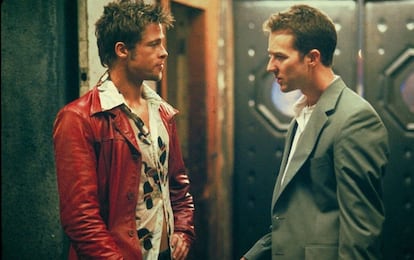
A delayed-action masterpiece
24 years later, Fight Club is number 12 on the IMDb’s list of the top films in history. The hundreds of thousands of viewers who went to see it in the fall of 1999 and winter of 2000 would soon be joined by nearly six million who bought it on DVD or rented it from a video store. Empire stated in 2008 that Brad Pitt’s Tyler Durden was the best character in the history of cinema, above Darth Vader, The Joker, Han Solo, Hannibal Lecter and Indiana Jones.
John Naughton, editor of the international edition of Men’s Health, states that the film has had a profound influence on the construction of contemporary male identity, and ponders: “How do men define themselves in an increasingly feminized world? Without a war, without a struggle to put bread on the table, how do the ‘middle children of history’ find their role? What is the alternative to ‘working jobs we hate to buy shit we don’t need’?”
Fight Club came from very modest origins: the author of the novel on which the film was based, Chuck Palahniuk, wrote it in the spare time he had during his long days as a mechanic in a Portland truck repair shop. Palahniuk outlined the story in his mind and, as soon as he could take a break, he hastily jotted a couple of paragraphs on his notepad. Hence the raw, syncopated, high-octane style of what would begin as a short story of less than 30 pages (published in the 1995 anthology Pursuit of Happiness) before it became a novel a year later.
A Clockwork Orange for the Generation X
The writer claims that this “dark satire” began to take shape one spring weekend when he found himself involved in an absurd fight in an idyllic Oregon meadow by a lake with some insufferable campers whom he had asked to turn down the volume on their boom box. Next Monday, back at the shop, he noticed that his colleagues avoided asking him about the noticeable bruises on his eyelids and cheekbones. “As long as you get to work on time, no one cares if you spend your weekends giving and receiving beatings.” Even violence or psychopathy is tolerated if it does not interfere with your work. This is how hypocritical and horrible our societies are. This notion gave rise to the novel’s nameless narrator, a guy so overwhelmed by the absurdity and emptiness of his daily routine that he needs to be beaten senseless just to see if he is still capable of feeling anything.
Palahniuk always knew he had a big story on his hands, but circumstances conspired so that he could only obtain a meager yield from it. The publisher W.W. Norton agreed to print the expanded version of his story, but paid him an advance of just $7,000. Although the novel received generally positive reviews (no one saw it as a defense, neither explicit nor veiled, of fascism), the first edition did not sell more than 5,000 copies. The good news came in 1997 when Fox bought the film adaptation rights, an operation that, despite everything, only brought the author an additional $10,000.
David Fincher insists that he always read Palahniuk’s text as an exhortation to find some meaning in our lives “before the void swallows us.” For him, Tyler Durden, who sold soap made from liposuction fat, and who encourages the protagonist of the story to seek solace in anarchic violence, is not a role model at all, but rather a terrible influence and a mentally ill person, more worthy of being pitied than imitated. This was also how Brad Pitt, Edward Norton and Helena Bonham Carter, the three main actors in the film, saw him.
Brad Pitt was approached by Fincher, script in hand, one night in 1997, as the actor returned to his Manhattan duplex after a day filming Meet Joe Black. He was worried that, after the strong momentum of the first years of his career, he was beginning to get typecast into handsome heartthrob roles. The character that Fincher offered him, a disturbed individual with a lot of charisma and very few scruples, seemed like the answer to his prayers. Norton was going through a period of critical reevaluation of his career, and he wanted the films he made to be as extreme as possible. And Bonham Carter wanted to work with good directors on atypical projects. None of them thought that Palahniuk’s novel, or the script that it became, could be taken as an apology for ultra-conservative values or toxic masculinity. Fincher assured them that he planned to imbue it with sarcasm, irreverence and black humor; this was going to be a fierce satire that no one could ever take literally. And he kept his word.
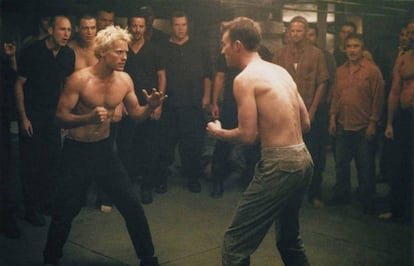
Literal delusions
However, the ways of reception and interpretation are inscrutable. Fincher already had to defend himself in 1999 from those who accused him of glorifying violence and embracing an irresponsible anarcho-individualism that bordered on the far right. The shadow of this literal reading of the film has haunted him ever since. Next Friday, Fincher will release on Netflix his latest film, The Killer, a claustrophobic thriller starring Michael Fassbender, Tilda Swinton and Arliss Howard. Just a few days ago, in an interview with the British newspaper The Guardian, the filmmaker assumed that the incel movement (misogynistic young men who consider sexual satisfaction a right that women deny them, “condemning” them to forced celibacy) has appropriated the film and turned it into one of their cultural fetishes.
Incels and other neoconservatives and apologists of aggressive masculinity do see Tyler Durden as a role model, and are more than willing to take the film’s discourse at face value, ignoring its implications and subtexts. In his defense, Fincher uses the most obvious and sensible of speeches: “I’m not responsible for how people interpret things. Language evolves. Symbols evolve.”
As painful as it may be for him, it is clear that both the film and (to a lesser extent) the novel are today part of the “lexicography” of a new right, much more active and belligerent than that of the 1990s. “We didn’t make it for them,” Fincher insists, “but people will see what they’re going to see in a Norman Rockwell painting, or [Picasso’s] Guernica,” regardless of the intentions of their authors.
Fincher finds it hard to believe that Tyler Durden is not perceived as what he is: a harmful illusion, one of the steps that inevitably lead the narrator towards his own hell. Project Mayhem, the anarchist plot against credit card companies, is nothing more than the ravings of a sick mind, and the Fight Clubs, although they still proliferate among circles of right-wing extremists, white supremacists and other radical groups since the film was released, were never intended to be an antidote to the rigors and dissatisfactions of modern life.
Portrait of a man on fire
Fincher adds that his film continues to garner misunderstandings left and right, and not just among those who insist on misinterpreting it and putting it at the service of shady ideas. Last year, a Chinese audiovisual platform bought the film to release it with an alternative ending that completely disrupts its meaning. In the ending created by Fincher (huge spoiler ahead; you’ve been warned), the narrator gets rid of his alter ego, Tyler Durden, moments before meeting his lover, Marla, to see from a large window as the skyscrapers of Manhattan’s financial district begin to explode. As Where Is My Mind plays — the Pixies song that Fincher insisted on incorporating into the film — the antihero with a fractured personality tells Marla one of the great lines of contemporary cinema: “You met at a very strange time in my life.”
The Chinese viewers did not see this ending. Instead, a sloppy fade-to-black after Durden’s death is followed by a text explaining that the authorities managed to abort the chaotic and lethal Project Mayhem after all. For Fincher, the aggression of the censors is as treacherous as it is unnecessary: “I will never understand those who say: ‘I love your film, I want it on my platform. But, of course, I’m going to make a series of arbitrary changes to turn it into something different.’ With the amount of audiovisual fictions that exist out there, what need do they have to distort one that was released more than 20 years ago?”
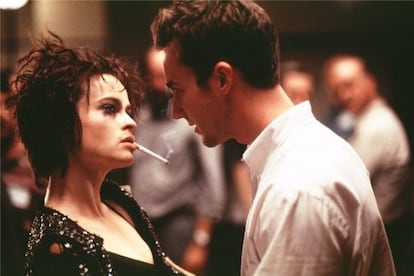
Sign up for our weekly newsletter to get more English-language news coverage from EL PAÍS USA Edition
Tu suscripción se está usando en otro dispositivo
¿Quieres añadir otro usuario a tu suscripción?
Si continúas leyendo en este dispositivo, no se podrá leer en el otro.
FlechaTu suscripción se está usando en otro dispositivo y solo puedes acceder a EL PAÍS desde un dispositivo a la vez.
Si quieres compartir tu cuenta, cambia tu suscripción a la modalidad Premium, así podrás añadir otro usuario. Cada uno accederá con su propia cuenta de email, lo que os permitirá personalizar vuestra experiencia en EL PAÍS.
¿Tienes una suscripción de empresa? Accede aquí para contratar más cuentas.
En el caso de no saber quién está usando tu cuenta, te recomendamos cambiar tu contraseña aquí.
Si decides continuar compartiendo tu cuenta, este mensaje se mostrará en tu dispositivo y en el de la otra persona que está usando tu cuenta de forma indefinida, afectando a tu experiencia de lectura. Puedes consultar aquí los términos y condiciones de la suscripción digital.
More information
Archived In
Últimas noticias
Welcome to the post-religion era: The idea of Christianity as the absolute truth has become obsolete
‘I thought you would like it’: The risky sexual practice popularized by TV shows and TikTok
The digitalization of tourism: ‘They promise experiences and gave us the worst possible one’
Mexican peso defies uncertainty with forecasts of a new period of stability in 2026
Most viewed
- Sinaloa Cartel war is taking its toll on Los Chapitos
- Reinhard Genzel, Nobel laureate in physics: ‘One-minute videos will never give you the truth’
- Oona Chaplin: ‘I told James Cameron that I was living in a treehouse and starting a permaculture project with a friend’
- Why the price of coffee has skyrocketed: from Brazilian plantations to specialty coffee houses
- Silver prices are going crazy: This is what’s fueling the rally


